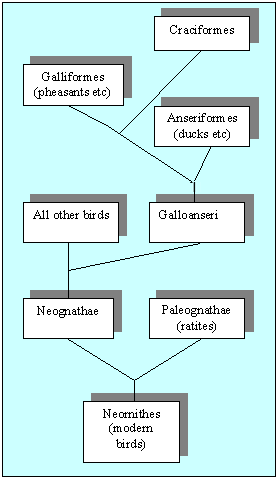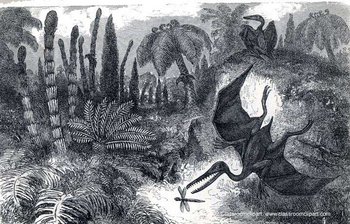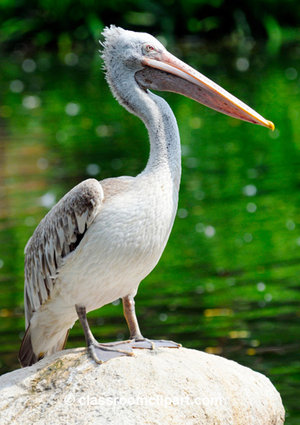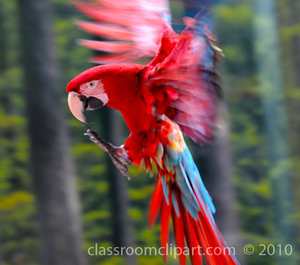Bird
|
|
| Revision as of 01:23, 24 Nov 2012 AcademicSysop (Talk | contribs) ← Go to previous diff |
Revision as of 01:24, 24 Nov 2012 AcademicSysop (Talk | contribs) Evolution Go to next diff → |
||
| Line 57: | Line 57: | ||
| Birds are generally considered to have evolved from [[Theropoda|theropod]] [[Dinosauria|dinosaur]]s. Specifically, birds are members of [[Maniraptora]], a group of theropods which includes dromaeosaurs and oviraptorids. As more non-avian theropods that are closely related to birds are discovered, the formerly clear distinction between non-birds and birds becomes less so. Recent discoveries in North-east [[China]] ([[Liaoning]] Province) demonstrating that many small [[Theropoda|theropod]] [[Dinosauria|dinosaurs]] had [[feather]]s contribute to this ambiguity. | Birds are generally considered to have evolved from [[Theropoda|theropod]] [[Dinosauria|dinosaur]]s. Specifically, birds are members of [[Maniraptora]], a group of theropods which includes dromaeosaurs and oviraptorids. As more non-avian theropods that are closely related to birds are discovered, the formerly clear distinction between non-birds and birds becomes less so. Recent discoveries in North-east [[China]] ([[Liaoning]] Province) demonstrating that many small [[Theropoda|theropod]] [[Dinosauria|dinosaurs]] had [[feather]]s contribute to this ambiguity. | ||
| [[Image:Dinosaur bird flying.jpg|thumb|350px]] | [[Image:Dinosaur bird flying.jpg|thumb|350px]] | ||
| - | The basal bird ''[[Archaeopteryx]]'', from the [[Jurassic]], is well-known as one of the first "missing links" to be found in support of [[evolution]] in the late [[19th century]]. It remains the most primitive known bird. Other [[Mesozoic]] birds include the [[Confuciusornithidae]], [[Enantiornithes]], ''[[Ichthyornis]]'', and [[Hesperornithiformes]], a group of flightless divers resembling [[grebe]]s and [[loon]]s. | + | The basal bird ''[[Archaeopteryx]]'', from the [[Jurassic]], is well-known as one of the first "missing links" to be found in support of [[evolution]] in the late [[19th century]]. It remains the most primitive known bird. Other [[Mesozoic]] birds include the Confuciusornithidae, Enantiornithes, Ichthyornis, and Hesperornithiformes, a group of flightless divers resembling [[grebe]]s and [[loon]]s. |
| The recently discovered dromaeosaur, ''[[Cryptovolans]]'', was capable of powered flight, contained a [[keel (bird)|keel]] and had ribs with [[uncinate]] processes. In fact, ''[[Cryptovolans]]'' makes a better "bird" than ''[[Archaeopteryx]]'' which is missing some of these modern bird features. Because of this, some paleontologists have suggested that [[dromaeosaur]]s are actually basal birds whose larger members are secondarily flightless. Evidence for this theory is currently inconclusive. | The recently discovered dromaeosaur, ''[[Cryptovolans]]'', was capable of powered flight, contained a [[keel (bird)|keel]] and had ribs with [[uncinate]] processes. In fact, ''[[Cryptovolans]]'' makes a better "bird" than ''[[Archaeopteryx]]'' which is missing some of these modern bird features. Because of this, some paleontologists have suggested that [[dromaeosaur]]s are actually basal birds whose larger members are secondarily flightless. Evidence for this theory is currently inconclusive. | ||
Revision as of 01:24, 24 Nov 2012
| Birds | ||||||
|---|---|---|---|---|---|---|
 Great Tit | ||||||
| Scientific classification | ||||||
| ||||||
| Orders | ||||||
|
Many - see section below.
|
Birds are bipedal, warm-blooded, egg-laying vertebrates characterized primarily by feathers, forelimbs modified as wings, and hollow bones.
Birds range in size from the tiny hummingbirds to the huge Ostrich and Emu. Depending on taxonomic viewpoint, there are between about 8,800-10,200 living bird species (and about 120-130 which have become extinct in the span of human history) in the world, making them the most diverse class of terrestrial vertebrates.
Birds are a very differentiated class, with some feeding on nectar, seeds, insects, rodents, fish, carrion, or other birds. Most birds are diurnal, or active during the day. Some birds, such as the owls and nightjars, are nocturnal or crepuscular (active during twilight hours). Many birds migrate long distances to utilise optimum habitats (e.g., Arctic Tern) while others spend almost all their time at sea (e.g. the Wandering Albatross). Some, such as frigatebirds, stay aloft for days at a time, even sleeping on the wing.
Common characteristics of birds include a bony beak with no teeth, the laying of hard-shelled eggs, high metabolic rate, and a light but strong skeleton. Most birds are characterised by flight, though the ratites are flightless, and several other species, particularly on islands, have also lost this ability. Flightless birds include the penguins, Ostrich, kiwi, and the extinct Dodo. Flightless species are vulnerable to extinction when humans or the mammals they introduce arrive in their habitat, for example the Great Auk, flightless rails, and the moa of New Zealand.
| Contents |
Bird orders
This is a list of the taxonomic orders in the class Aves. List of birds gives a more detailed summary, including families.
- Struthioniformes, Ostrich, emus, kiwis, and allies
- Tinamiformes, tinamous
- Anseriformes, waterfowl
- Galliformes, fowl
- Sphenisciformes, penguins
- Gaviiformes, loons
- Podicipediformes, grebes
- Procellariiformes, albatrosses, petrels, and allies
- Pelecaniformes, pelicans and allies
- Ciconiiformes, storks and allies
- Phoenicopteriformes, flamingos
- Accipitriformes, eagles, hawks and allies
- Falconiformes, falcons
- Turniciformes, button-quail
- Gruiformes, cranes and allies
- Charadriiformes, plovers and allies
- Pteroclidiformes, sandgrouse
- Columbiformes, doves and pigeons
- Psittaciformes, parrots and allies
- Cuculiformes, cuckoos
- Strigiformes, owls
- Caprimulgiformes, nightjars and allies
- Apodiformes, swifts
- Trochiliformes, hummingbirds
- Coraciiformes, kingfishers
- Piciformes, woodpeckers and allies
- Trogoniformes, trogons
- Coliiformes, mousebirds
- Passeriformes, passerines
Evolution
Birds are generally considered to have evolved from theropod dinosaurs. Specifically, birds are members of Maniraptora, a group of theropods which includes dromaeosaurs and oviraptorids. As more non-avian theropods that are closely related to birds are discovered, the formerly clear distinction between non-birds and birds becomes less so. Recent discoveries in North-east China (Liaoning Province) demonstrating that many small theropod dinosaurs had feathers contribute to this ambiguity.
The basal bird Archaeopteryx, from the Jurassic, is well-known as one of the first "missing links" to be found in support of evolution in the late 19th century. It remains the most primitive known bird. Other Mesozoic birds include the Confuciusornithidae, Enantiornithes, Ichthyornis, and Hesperornithiformes, a group of flightless divers resembling grebes and loons.
The recently discovered dromaeosaur, Cryptovolans, was capable of powered flight, contained a keel and had ribs with uncinate processes. In fact, Cryptovolans makes a better "bird" than Archaeopteryx which is missing some of these modern bird features. Because of this, some paleontologists have suggested that dromaeosaurs are actually basal birds whose larger members are secondarily flightless. Evidence for this theory is currently inconclusive.
It should be noted that although ornithischian (bird-hipped) dinosaurs share the same hip structure as birds, birds actually originated from the saurischian (lizard-hipped) dinosaurs, and thus arrived at their hip structure condition independently. In fact, the bird-like hip structure developed a third time among a peculiar group of theropods, the Therizinosauridae.
Modern birds are classified in Neornithes, which are split into the Paleognathae and Neognathae. The paleognaths include the tinamous (found only in Central and South America) and the ratites. The ratites are large flightless birds, and include ostriches, cassowaries, kiwis and emus; some scientists suspect that the ratites represent an artificial grouping of birds which have independently lost the ability to fly, others contend that the ratites never had the ability to fly and are more directly related to the dinosaurs. The basal divergence from the remaining Neognathes was that of the Galloanseri, the superorder containing the Anseriformes (ducks, geese and swans), and the Galliformes (the pheasants, grouse, and their allies). See the chart.
The classification of birds is a contentious issue. Sibley & Ahlquist's Phylogeny and Classification of Birds (1990) is a landmark work on the classification of birds (although frequently debated and constantly revised). Evidence for the various orders seems to be fairly good, but the relationships between the orders are in a state of disarray. Evidence from modern bird anatomy, fossils and DNA have all been brought to bear on the problem but no strong consensus has emerged. See also: Sibley-Ahlquist taxonomy.
Reproduction
Although most male birds have no external sex organs, the male does have two testes which become hundreds of times larger during the breeding season to produce sperm. The female's ovaries also become larger, although only the left ovary actually functions.
In the males of species without a phallus (see below), sperm is stored within the proctodeum compartment within the cloaca prior to copulation. During copulation, the female moves her tail to the side and the male either mounts the female from behind or moves very close to her. He moves the opening of his cloaca, or vent, close to hers, so that the sperm can enter the female's cloaca, in what is referred to as a cloacal kiss. This can happen very fast, sometimes in less than one second.
The sperm is stored in the female's cloaca for anywhere from a week to a year, depending on the species of bird. Then, one by one, eggs will descend from the female's ovaries and become fertilized by the male's sperm, before being subsequently laid by the female. The eggs will then continue their development in the nest.
Many waterfowl and some other birds, such as the ostrich and turkey, do possess a phallus. Except during copulation, it is hidden within the proctodeum compartment within the cloaca, just inside the vent. The avian phallus differs from the mammalian penis in several ways, most importantly in that it is purely a copulatory organ and is not used for dispelling urine.
After the eggs hatch, parent birds provide varying degrees of care in terms of food and protection. Precocial birds can care for themselves independently within minutes of hatching; altricial hatchlings are helpless, blind, and naked, and require extended parental care. The chicks of many ground-nesting birds such as partridges and waders are often able to run virtually immediately after hatching; such birds are referred to as nidifugous. The young of hole-nesters, on the other hand, are often totally incapable of unassisted survival. "Fledging" is the process of a chick acquiring feathers until it can fly.
Some birds, such as pigeons, geese, and Red-crowned Cranes, remain with their mates for life (or for a long period) and may produce offspring on a regular basis.
Mating systems and parental care
Sources for this section include:
- Gowaty, Patricia Adair: Male Parental Care and Apparent Monogamy among Eastern Bluebirds (Sialia Sialis). The American Naturalist 121(2): 149-160 (1983).
- Ketterson, Ellen D. and Nolan, Val: Male Parental Behavior in Birds. Annual Review of Ecology and Systematics 25: 601-28 (1994).
- Zeveloff, Samuel and Boyce, Mark: Parental Investment and Mating Systems in Mammals. Evolution 34(5): 973-982 (1980).
The three predominant mating systems are polyandry, polygyny, and monogamy. Monogamy is seen in approximately 91% of all bird species. Polygyny constitutes 2% of all birds and polyandry is seen in less than 1%. Monogamous species of males and females pair for the breeding season. In some cases, the individuals may pair for life. Sexual selection theory and the relatively low typical parental investment that males make in offspring would suggest that polygynous mating systems should predominate in the animal kingdom. The real puzzle then is why do males become monogamous at all, especially so often in bird species.
In most groups of animals, male parental care is rare, but in birds it is quite common; it is more extensive in birds than in any other vertebrate class. One reason for this large percentage of monogamy with birds is due to the fact that male birds are just as adept at parental care as females. In fact, male care can be seen as important or essential to female fitness. "In one form of monogamy such as with obligate monogamy a female cannot rear a litter without the aid of a male" (Gowaty, 1983). It is assumed that when such male care is necessary, monogamy will evolve directly with this. It seems strange then that a male?s ability to defend mates and resources relies on his ability to separate himself from parental care.
The parental behavior most associated with monogamy was male incubation. This is very interesting, because male incubation is the most confining male parental behavior. It not only consumes time, but also may require physiological changes that interfere with usual mating. With the extreme loss of mating opportunities, there is a reduction in the reproductive success among males. "This information then suggests that sexual selection may be less intense in taxa where males incubate, hypothetically because males allocate more effort to parental care and less to mating" (Ketterson and Nolan, 1994). It is understood then that the females associated with these males base their choice of mate on parental behaviors rather than physical appearance.
It is surprising that with the amount of time and energy needed, that paternal care is selected for at all. Evolution suggests that a female should choose mates that confer maximum fitness. Therefore, if males contribute to the care of the offspring both male and female fitness may be maximized. "High paternal care has been seen among many species of monogamous mammals and several authors suggest that male investment is one of the primary advantages of monogamous mating (Zeveloff and Boyce, 1980). This suggests then that this mating system whether costly or not must be advantageous in some way or these females would not be selecting males with this behavior.
It seems likely that fitness is increased in some way by this behavior of male parental care, but not so extreme that it is adopted by most other species. Surprisingly, there appears to be a lot of research to show that monogamy and paternal behavior are actually maladaptive due to its cost to fitness. However, is this due to the use of male care in this mating system? While the answer may be yes, it also seems to prevail in bird populations for some reason. What this reason is though may never be pin pointed to an exact answer. Some observations are thrown out by a couple of researchers but with no conclusive data or results. The only thing concluded seems to be that it is unnecessary. For now, until more research is done, we must instead be content to just know it persists.
Respiration
Birds respire by means of crosscurrent flow: the air flows at a 90 degree angle to the flow of blood in the lungs capillaries. In addition to the lungs themselves, birds have posterior and anterior air sacs (typically nine) which control air flow through the lungs, but do not play a direct role in gas exchange. There are three parts involved in respiration:
- the anterior air sacs (interclavicular, cervicals, and anterior thoracics),
- the lungs, and
- the posterior air sacs (posterior thoracics & abdominals).
It takes a bird two full breaths (inhaling and exhaling), to completely cycle the air from each inhalation through the lungs and out again. The air flows through air sacs and lungs as follows.
- First inhalation: air flows through the trachea and bronchi into the posterior air sacs.
- First exhalation: air flows from the posterior air sacs to the lungs.
- Second inhalation: air flows from the lungs to the anterior air sacs.
- Second exhalation: air flows from the anterior sacs back through the trachea and out of the body.
In birds, at each inhalation and each exhalation fresh air flows through the lungs in only one direction. Birds are therefore able to diffuse more oxygen into their blood. Unlike humans and other mammals, there is no mixing of oxygen rich air and carbon dioxide rich air. Thus, the partial pressure of oxygen in a bird's lungs is the same as the environment. This is also why you would more likely see a bird on Mount Everest than, say, a mouse.
Avian lungs do not have alveoli, as mammalian lungs do, but instead contain millions of tiny passages known as parabronchi, connected at either ends by the dorsobronchi and ventrobronchi. Air flows through the honeycombed walls of the parabronchi and into air capillaries, where oxygen and carbon-dioxide are traded with cross-flowing blood capillaries by diffusion.
Other anatomy
Bird.parts.jpg
Birds posses a ventriculus, or gizzard, that is composed of four muscular bands that act to rotate and crush food by shifting the food from one area to the next within the gizzard. Depending on the species, the gizzard may contain small pieces of grit or stone that the bird has swallowed to aid in the grinding process of digestion. For birds in captivity, only certain species of birds require grit in their diet for digestion. The use of gizzard stones is a similarity between birds and dinosaurs, which left gizzard stones called gastroliths as trace fossils.
Birds and humans
Iso_linnunpontto.jpg
Birds are an important food source for humans. The most commonly eaten species is the domestic chicken and its eggs, although geese, pheasants, turkeys, and ducks are also widely eaten. Other birds that have been utilized for food include emus, ostriches, pigeons, grouse, quails, doves, woodcocks, songbirds, and others, including small passerines such as finches.
At one time swans and flamingos were delicacies of the rich and powerful, although these are generally protected now.
Many species have become extinct through over-hunting, such as the Passenger Pigeon, and many others have become endangered or extinct through habitat destruction, deforestation and intensive agriculture being common causes for declines.
Numerous species have come to depend on human activities for food and are widespread to the point of being pests. For example the common pigeon or Rock Dove (Columba livia) thrives in urban areas around the world. In North America, introduced House Sparrows, Common Starlings, and House Finches are similarly widespread.
Other birds have been used by humans: for example Homing pigeons to carry messages (many are still kept for sport), falcons for hunting, cormorants for fishing. Chickens and pigeons are popular subjects in experimental research in biology and comparative psychology. As birds are extra-sensitive to toxins, the Canary was often used in coal mines to indicate the presence of poisonous gases, so that the miners could escape.
Colorful, particularly tropical, birds (e.g., parrots, and mynahs) are often kept as pets although this has led to smuggling of some endangered species; CITES does considerable work to deter this.
Bird diseases that can be contracted by humans include: psittacosis, salmonellosis, campylobacteriosis, Newcastle's disease, mycobacteriosis (avian tuberculosis), influenza, giardiasis, and cryptosporiadiosis.
Trivia
- To preen or groom their feathers, birds use their bills to brush away foreign particles.
- The birds of a region are called the avifauna.
- Few birds use chemical defences against predators. Tubenoses can eject an unpleasant slime against an aggressor, and some species of pitohui, found in New Guinea secrete a powerful neurotoxin in their feathers.
- Birds are among the most extensively studied animal groups, with hundreds of academic journals devoted to their study.
See also
- Anting
- Archaeopteryx
- Avian pallium
- Bird flight
- Bird migration
- Bird ringing (banding)
- Birdfeeding
- Birding
- Carinatae
- Conservation status
- Egg biology
- Extinct birds
- List of birds
- regional and country bird lists
- Oology
- Ornithology
- Prehistoric birds
Bird families and taxonomic discussion are given in list of birds and Sibley-Ahlquist taxonomy.
Bird Clipart and Pictures
- Bird Clipart (http://classroomclipart.com/clipart/Clipart/Animals/Bird_Clipart.htm)
- Bird Pictures (http://classroomclipart.com/clipart/Animals/Birds.htm)
- Bald Eagle Pictures (http://classroomclipart.com/clipart/Animals/Birds/Bald_Eagle.htm)
- Ducks and Geese Pictures (http://classroomclipart.com/clipart/Animals/Birds/Ducks_and_Geese.htm)
- FlamingoPictures (http://classroomclipart.com/clipart/Animals/Birds/Flamingos.htm)
- General Bird Pictures (http://classroomclipart.com/clipart/Animals/Birds/General.htm)
- Bird Illustrations (http://classroomclipart.com/clipart/Animals/Birds/Illustrations.htm)
- Ostrich Pictures (http://classroomclipart.com/clipart/Animals/Birds/Ostrich.htm)
- Owl Pictures (http://classroomclipart.com/clipart/Animals/Birds/Owl.htm)
- Parrot Pictures (http://classroomclipart.com/clipart/Animals/Birds/Parrots.htm)
- Peacock Pictures (http://classroomclipart.com/clipart/Animals/Birds/Peacock.htm)
- Pelican Pictures (http://classroomclipart.com/clipart/Animals/Birds/Pelicans.htm)
- Penguin Pictures (http://classroomclipart.com/clipart/Animals/Birds/Penguins.htm)






